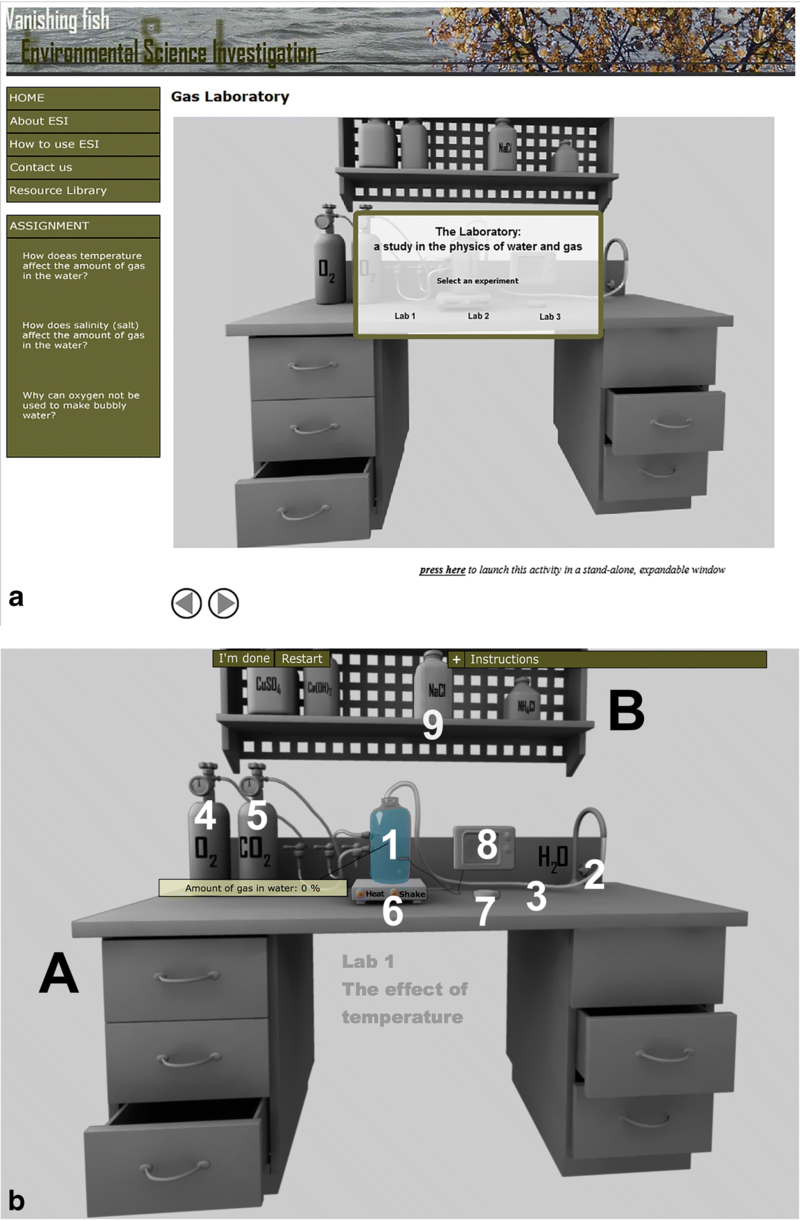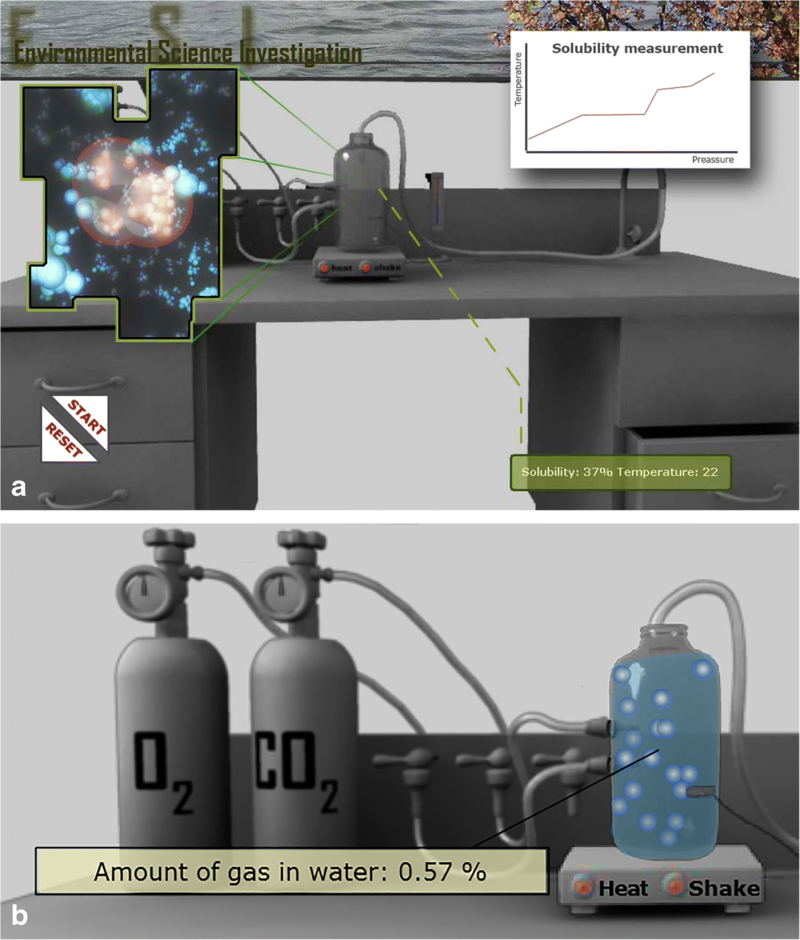Science simulation
Introduction
Science simulations are computer simulations that focus on science areas, in particular: physics, biology, chemistry, and earth science. In this article we will present general principles and examples.
See also:
- computer simulation
- virtual laboratory (most of these are simulations embedded in a "visual real-life" environment")
- math simulation
There exist many types of simulations. Most simulations allow learners to manipulate parameters and they include visualizations that go beyond presenting pure numbers. We could distinguish between simulations that provide purely conceptual controls and visualizations and others that present a more or less stylized "real world" view. Below we will present an example for both.
PHET Interactive Simulations
“Founded in 2002 by Nobel Laureate Carl Wieman, the PhET Interactive Simulations project at the University of Colorado Boulder creates free interactive math and science simulations. PhET sims are based on extensive education research and engage students through an intuitive, game-like environment where students learn through exploration and discovery.” Interactive Simulations For Science And Math (retr. April 24, 2019).
See PhET interactive simulations for details
The Gas laboratory
The gas laboratory is a web-based environment for environmental science investigation that include a virtual laboratory simulation. As explained in the about ESI page, “the main learning objective with this site is to spread knowledge on relations between environmental change and conditions for life. The ESI site describes and investigates the problem of declining salmon populations in the Fraser River, Canada which exemplifies an observed phenomenon where global warming is thought to play a major role.”. The web site contains ten 30-60 minute activities that can be used in any order, but for best learning outcomes, it is recommended to do all activities from the first to the last. Most activities engage students in reading or looking at a multimedia resource and there is only one included simulation.
In the case of the gas laboratory, most learning activities are centered around reading and answering questions. Smaller simulations are a key elements in central activities. More precisely, “the functions of the Gas Laboratory included three laboratory tests investigating the solubility of gases in water.” [1]. The simulated laboratory mimicked a real world environment with semi-realistic workbench details. As Stahre Wästberg et al. [1] notice, “In the Gas Laboratory, neither visual realism nor complex interaction was actually required. The intent of the laboratory was to let students observe the amount of gas bubbles when changing three physical parameters (temperature, pressure and salinity), and to have them discuss and interpret what these gas bubbles actually meant.”. They add that “Research within visualisation clearly suggests that in many circumstances a stylised image is more efficient and easier to understand than one with a higher degree of realism and detail (Ryan and Schwartz 1956) [2]. The evaluation of the Gas Laboratory indicates that the students did not request a more realistic representation of the laboratory environment; the students’ concern was rather how to interpret the amount of bubbles in different stages of the experiment.”
Below we show a few screenshots published by Wästberg et al. (2019) [1] under a Creative Commons licence. As you can see, the simulation is embedded within a learning activity that prompts the student to answer three questions.

The next picture showed that the virtual environment is enhanced, i.e. includes information that one could not directly see in the same way in a real laboratory.
Unfortunately, the environment uses flash that is not longer available by default in web browsers.
Guiding
As also discussed in the guided discovery community, giving a "pure" simulation to a student is not very effective. Both researchers and practitioners agree that learners need some explicit or implicit guidance and scaffolding. The question is how and how much. “When used in class, simulations become part of an integrated system of resources that guide learning – including implicit guidance from the simulation, as well as explicit guidance from the written activity and the instructor (Hennessy et al., 2006; Lee et al., 2006; Chang et al., 2008; Khan, 2011). While much research has contributed to present knowledge of optimal design elements for interactive simulations (Lee et al.,2006; Adams et al., 2008b; Plasset al., 2009), less is known about how the amount, timing, and type of guidance affects students’ interaction, interpretation, and learning with these educational tools” (Chamberlain et al. (2014:628) [3] .
Perkins et al. (2012) [4] highlight the overarching importance and use of implicit scaffolding within sims. “Explicit scaffolding or guidance is ubiquitous in education. Within science instruction, an environment with significant explicit guidance can result in students merely following directions as opposed to engaging in sense- making and productive inquiry. Implicit scaffolding aims to retain a student’s sense of autonomy while creating an environment in which multiple, natural, investigative pathways and questions lead toward the desired knowledge acquisition. In short, implicit scaffolding guides without students feeling guided.”
Chamberlain et al. (2014:628) [3] compared three levels of guidance: heavy, medium and light. “Simulation features were characterized as “prompted” or “exploratory” based on the presence or absence of explicit guidance in the written activity to use that feature. While students in every condition were engaged with the simulation and their activity, student interaction with “exploratory” features decreased significantly when more guidance was provided (LG = 85%, MG = 68%, HG = 9%, p < 0.0005). Lighter guidance groups explored more and attended to their simulation interactions, indicated by a redraw task in the week after use. These results indicate that activity design – in terms of guidance level – can strongly influence student exploration with an interactive simulation.” In other words, if the learning goal includes to teach scientific reasoning, then there should not be too much external guidance, otherwise students will just follow instructions. The authors conclude that research should be more interested in the process by which students engage in simulations, because it will inform the design of the simulation itself but also of lesson plans and learning activities. Based on this research, Chamberlain et al. (2014:37) [3] make the following recommendation for teachers, but also leave the teachers the choice to use a more structure Guided discovery learning model.
Their key recommendation is to work with simulation environments that implement some form of implicit guidance, i.e. "affordable" tools that steer students to explore the simulation in meaningful directions.
Bibliography
Cited with footnotes
- ↑ 1.0 1.1 1.2 1.3 1.4 Stahre Wästberg, B., Eriksson, T., Karlsson, G., Sunnerstam, M., Axelsson, M., & Billger, M. (2019). Design considerations for virtual laboratories: A comparative study of two virtual laboratories for learning about gas solubility and colour appearance. Education and Information Technologies, 24(3), 2059–2080. https://doi.org/10.1007/s10639-018-09857-0
- ↑ Ryan, T. A., & Schwartz, C. B. (1956). Speed of perception as a function of mode of representation. American Journal of Psychology, 69, 60–69.
- ↑ 3.0 3.1 3.2 Chamberlain, J. M., Lancaster, K., Parson, R., & Perkins, K. K. (2014). How guidance affects student engagement with an interactive simulation. Chemistry Education Research and Practice, 15(4), 628–638. https://doi.org/10.1039/c4rp00009a
- ↑ Perkins, K. K., Podolefsky, N. S., Lancaster, K., & Moore, E. B. (2012). Creating Effective Interactive Tools for Learning: Insights from the PhET Interactive Simulations Project. EdMedia + Innovate Learning, 2012(1), 436–441. Retrieved from https://www.learntechlib.org/p/40781/
Other
- Adams W. K., Reid S., LeMaster R., McKagan S. B., Perkins K. K.,Dubson M. and Wieman C. E., (2008a), A study of educationalsimulations part I – engagement and learning,J. Interact.Learn. Res.,19, 397–419.
- Adams W. K., Reid S., LeMaster R., McKagan S. B., Perkins K. K.,Dubson M. and Wieman C. E., (2008b), A study of educationalsimulations part II – interface design,J. Interact. Learn. Res.,19,551–577
- Chang K.-E., Chen Y.-L., Lin H.-Y. and Sung Y.-T., (2008), Effectsof learning support in simulation-based physics learning,Comput. Educ.,51, 1486–1498
- Hennessy S., Deaney R. and Ruthven K., (2006), Situatedexpertise in integrating use of multimedia simulation intosecondary science teaching,Int. J. Sci. Educ.,28(7), 701–732.
- Khan S., (2011), New pedagogies on teaching science withcomputer simulations,J. Sci. Educ. Technol.,20, 215–232.
- Lee H., Plass J. L. and Homer B. D., (2006), Optimizing cognitiveload for learning from computer-based science simulations,J. Educ. Psychol.,98(4), 902–913.
